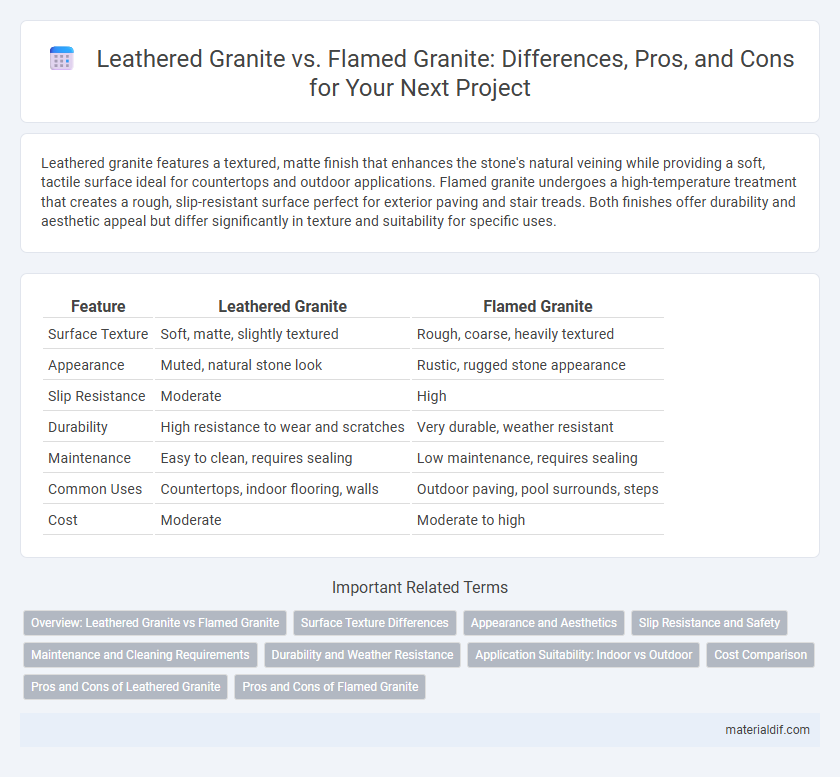Leathered granite features a textured, matte finish that enhances the stone's natural veining while providing a soft, tactile surface ideal for countertops and outdoor applications. Flamed granite undergoes a high-temperature treatment that creates a rough, slip-resistant surface perfect for exterior paving and stair treads. Both finishes offer durability and aesthetic appeal but differ significantly in texture and suitability for specific uses.
Table of Comparison
| Feature | Leathered Granite | Flamed Granite |
|---|---|---|
| Surface Texture | Soft, matte, slightly textured | Rough, coarse, heavily textured |
| Appearance | Muted, natural stone look | Rustic, rugged stone appearance |
| Slip Resistance | Moderate | High |
| Durability | High resistance to wear and scratches | Very durable, weather resistant |
| Maintenance | Easy to clean, requires sealing | Low maintenance, requires sealing |
| Common Uses | Countertops, indoor flooring, walls | Outdoor paving, pool surrounds, steps |
| Cost | Moderate | Moderate to high |
Overview: Leathered Granite vs Flamed Granite
Leathered granite features a soft, matte finish achieved through brushing, enhancing its natural texture and reducing glare, making it ideal for countertops and high-traffic surfaces. Flamed granite undergoes high-temperature treatment with a flame torch to create a rough, non-slip surface, commonly used in outdoor applications such as pavements and walkways. Both finishes highlight the stone's durability and aesthetic appeal, with leathered granite offering a subtle, tactile feel while flamed granite provides maximum traction and ruggedness.
Surface Texture Differences
Leathered granite features a soft, matte finish with a slightly textured surface that enhances the stone's natural colors and minimizes fingerprints and smudges. Flamed granite undergoes a high-temperature treatment that creates a rough, abrasive texture with pronounced ridges, offering excellent slip resistance and a rugged appearance. The choice between leathered and flamed granite depends on the desired aesthetic and functional requirements, as leathered surfaces provide subtle elegance while flamed surfaces emphasize durability and grip.
Appearance and Aesthetics
Leathered granite showcases a textured, matte surface with a soft, natural look that emphasizes the stone's inherent patterns and color variations, making it ideal for sophisticated, subtle designs. Flamed granite features a rough, rugged texture created by intense heat exposure, resulting in a brighter, more rugged appearance with enhanced slip resistance, suitable for outdoor and high-traffic spaces. The choice between leathered and flamed granite depends on desired tactile qualities and visual impact, balancing elegance with durability.
Slip Resistance and Safety
Leathered granite features a textured, matte surface that enhances slip resistance, making it a safer option for residential and commercial flooring. Flamed granite undergoes high-temperature treatment resulting in a rough, coarse texture that provides excellent traction on outdoor walkways and pool decks. Both finishes improve safety by minimizing slip hazards, but leathered granite offers a subtler, less abrasive surface ideal for interior settings.
Maintenance and Cleaning Requirements
Leathered granite features a textured surface that hides fingerprints and minor stains, requiring only regular dusting and mild soap for cleaning to maintain its appearance without heavy maintenance. Flamed granite, with its rough, porous surface created by intense heat treatment, tends to accumulate dirt and debris more easily, necessitating more frequent and thorough cleaning using a stiff brush and pH-balanced cleaners. Both finishes benefit from periodic sealing to prevent staining and preserve their durability in high-traffic areas.
Durability and Weather Resistance
Leathered granite offers enhanced durability through its textured surface, providing excellent resistance to scratches and stains, making it ideal for high-traffic outdoor areas. Flamed granite features a rough, slip-resistant finish achieved by exposing the stone to high-temperature flames, significantly improving its weather resistance and preventing surface wear from extreme weather conditions. Both finishes ensure long-lasting performance, but flamed granite is particularly favored for environments with heavy exposure to rain, snow, and freeze-thaw cycles.
Application Suitability: Indoor vs Outdoor
Leathered granite offers a smooth, textured surface ideal for indoor applications such as kitchen countertops and bathroom vanities, providing a warm, tactile finish that enhances aesthetic appeal while resisting scratches. Flamed granite, with its rough and slip-resistant texture, is highly suitable for outdoor use including walkways, patios, and pool surrounds, ensuring safety and durability under various weather conditions. Both finishes maintain granite's inherent strength and stain resistance, but application suitability depends on the desired surface texture and exposure to environmental elements.
Cost Comparison
Leathered granite typically costs more than flamed granite due to the intricate finishing process that enhances texture and appearance. Flamed granite offers a more budget-friendly option as the heating technique is quicker and less labor-intensive, leading to lower production expenses. Choosing between the two depends on balancing the desired aesthetic with the project's budget constraints.
Pros and Cons of Leathered Granite
Leathered granite offers a textured, matte finish that enhances slip resistance and hides fingerprints better than polished surfaces, making it ideal for high-traffic areas. Its durability resists scratches and stains, but the textured surface can be more challenging to clean compared to smoother finishes and may require more maintenance to prevent dirt accumulation. Unlike flamed granite, leathered granite provides a softer aesthetic while maintaining robust performance for kitchens and countertops.
Pros and Cons of Flamed Granite
Flamed granite offers a textured, slip-resistant surface ideal for outdoor applications like walkways and patios, enhancing safety and durability. Its rough finish resists weathering and hides scratches better than polished or leathered finishes but is more challenging to clean and maintain due to its uneven texture. Flamed granite may also show more dirt and requires regular brushing to preserve its appearance.
Leathered Granite vs Flamed Granite Infographic

 materialdif.com
materialdif.com